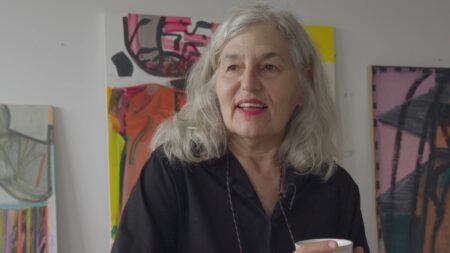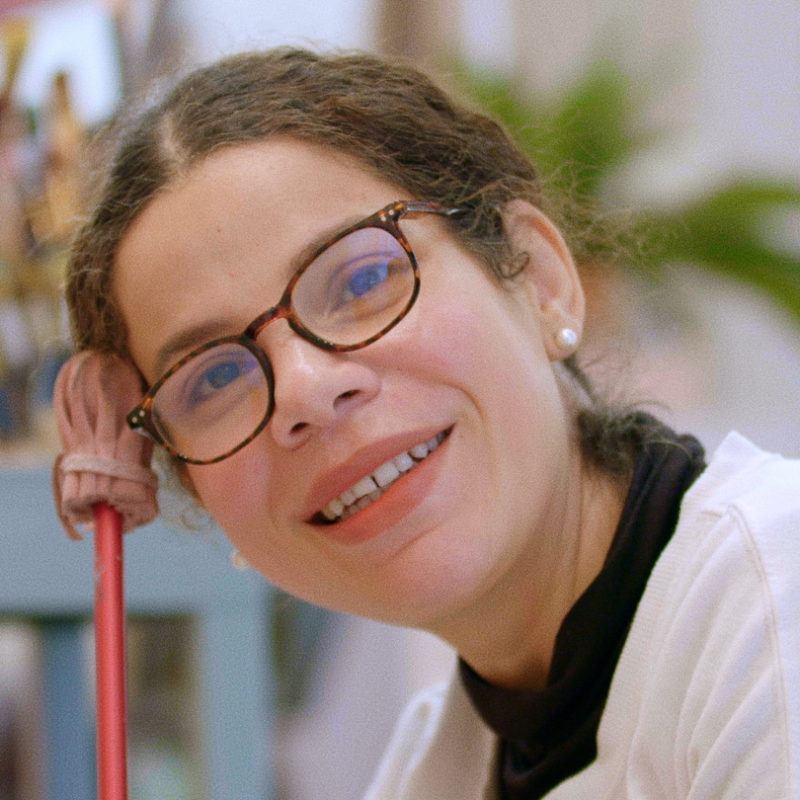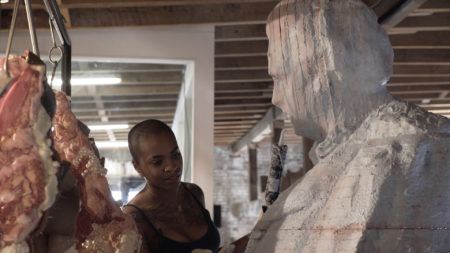Continue playing
(Time remaining: )
Play from beginning
Continue playing "{{ controller.videos[controller.getVideo(controller.currentVideo)].segmentParentTitle}}"
{{controller.videos[controller.getVideo(controller.currentVideo)].title}} has ended.
An Open Horizon (or) the Stillness of a WoundFirelei Báez
Visit our Awards page for this film’s honors and recognition.
Where can beauty be subversive? Working in her Bronx studio, artist Firelei Báez creates a series of paintings that draw upon the rich folklore and colonial history of the Caribbean, where she was born and raised. Exquisitely detailed and vibrantly colored, Báez’s paintings of dramatically shapeshifting figures assert the power of the female form and challenge fundamental ideas around beauty and agency. Shot primarily on film and featuring original choreography inspired by her paintings, this film is a portrait of an artist in creative transition—like the figures in her work—and in constant motion, traveling her surrounding Bronx neighborhood as well as to her glass mosaic commission at the 163rd Street-Amsterdam Avenue subway station in Manhattan.
Raised on the border of Dominican Republic and Haiti, the artist recounts her early creative experiences making hand-sewn books and paper dolls, activities which her family members largely perceived as trouble-making behavior. Today in her work, the artist evokes a similarly misunderstood character from Domincan folklore, the ciguapa, an evasive and cunning female figure. Although traditionally regarded as a siren-esque figure that ensnares explorers and derails society, Báez regards the ciguapa as a beacon of the “highly independent, self-possessed”—a deeply feeling woman she hopes to see in the world. Báez also references the 18th-century colonial taxonomist Carl Linnaeus—subverting his depictions of Black and Brown bodies that equated them to animals or monsters—in order to create new, more expansive possibilities for Afro-Latina and Afro-Caribbean peoples.
For Báez, the layered histories and symbols in her paintings are in conversation with the past, while holding a limitless hope for creating a better future. “Every choice we make is predicated by the people we love in the past and the people we hope to love in the future,” says the artist. “It’s always within your grasp to make something new.”
This film is among a collection that comprise Art21’s participation in the multi-institutional Feminist Art Coalition (FAC) initiative. FAC is a platform for art projects informed by feminisms, fostering collaborations between arts institutions that aim to make public their commitment to social justice and structural change.
More information and creditsCredits
New York Close Up Series Producer: Nick Ravich. Director: Souki Mehdaoui. Producers: Souki Mehdaoui and Hannah Swayze. Editors: Drigan Lee and Souki Mehdaoui. Cinematographer: Daniel Contaldo. Additional Camera: Souki Mehdaoui. Steadicam Operator: David Quateman. Assistant Camera: Rachel Fedorkova & Charlie Muentes. Gaffer: Luke Carquillat. Location Sound: Eamon Redpath. Sound Engineer: Jennifer Ruffalo. Production Assistant: Jo Barba. Choreographer: Maleek Washington. Dancers: Amanda Castro and Maleek Washington. Costume Designer: Meirav Ong. Music: Qasim Naqvi and Trevor New. Color Correction: Addison Post. Sound Design & Mix: Gisela Fullà-Silvestre. Design & Graphics: Andy Cahill and Chips. Additional Editor: Ora Dekornfeld. Artwork Courtesy: Firelei Báez, Dan Bradica, James Cohan Gallery, and Phoebe d’Heurle. Thanks: Ataria Pictures, Du-All Camera, Dungeon Beach, Anne Hubbel, Kodak, Camila Nichols, David Norr, Jake Oleson, and Jack Rizzo.
This film is possible thanks to Dawn and Chris Fleischner. New York Close Up is supported by The Andy Warhol Foundation for the Arts; and, in part, by public funds from the New York City Department of Cultural Affairs in partnership with the City Council; and by individual contributors.
Digital exhibition of New York Close Up films is made possible in part by the New York State Council on the Arts.
Closed captionsAvailable in English, German, Romanian, Italian, Japanese, Korean, Chinese, Italian
Through the Art21 Translation Project, multilingual audiences from around the globe can contribute translations, making Art21 films more accessible worldwide. Translate this video now.
Interested in showing this film in an exhibition or public screening? To license this video please visit Licensing & Reproduction.
Firelei Báez was born in 1981 in Santiago de los Caballeros, Dominican Republic, and lives and works in New York, NY. She received a BFA from the Cooper Union School of Art and an MFA from Hunter College. In her paintings, drawings, and installations, Báez draws upon a wide range of African diasporic histories, reworking visual imagery from sources such as Dominican folklore, 18th-century taxonomy, and the Black Panther movement in order to reclaim power and imagine new possibilities for the future.
“In most power relationships, you have the victim trying to solve the situation. I don’t want to create narratives of victimhood. I want to flip it.”
Firelei Báez
Disputed Historical Narratives
Shaun Leonardo




